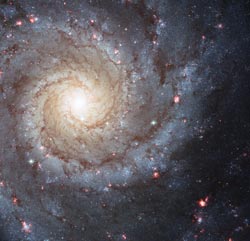Holiday Wishes from the Hubble Space Telescope

In the new Hubble image of the galaxy M74 we can also see a smattering of bright pink regions decorating the spiral arms. These are huge, relatively short-lived, clouds of hydrogen gas which glow due to the strong radiation from hot, young stars embedded within them; glowing pink regions of ionized hydrogen (hydrogen that has lost its electrons). These regions of star formation show an excess of light at ultraviolet wavelengths and astronomers call them HII regions. Image credit: NASA, ESA and the Hubble Heritage (STScI/AURA)-ESA/Hubble Collaboration<br>
In the new Hubble image we can also see a smattering of bright pink regions decorating the spiral arms. These are huge, relatively short-lived, clouds of hydrogen gas which glow due to the strong radiation from hot, young stars embedded within them; glowing pink regions of ionized hydrogen (hydrogen that has lost its electrons). These regions of star formation show an excess of light at ultraviolet wavelengths and astronomers call them HII regions.
Tracing along the spiral arms are winding dust lanes that begin very near the galaxy’s nucleus and follow along the length of the spiral arms. These spiral arms are not actually static ‘arms’ like spokes on a wheel. They are in fact density waves and move around the galaxy’s disc compressing gas – just as sound waves compress the air on Earth – creating a new generation of young blue stars.
Messier 74 is located roughly 32 million light-years away in the direction of the constellation Pisces, the Fish. It is the dominant member of a small group of about half a dozen galaxies, the Messier 74 galaxy group. In its entirety, it is estimated that Messier 74 is home to about 100 billion stars, making it slightly smaller than our Milky Way.
The spiral galaxy was first discovered by the French astronomer, Pierre Méchain, in 1780. Weeks later it was added to Charles Messier’s famous catalogue of deep-sky objects. Of all the objects in Messier’s catalogue, number 74 has the lowest surface brightness. It is so difficult for amateur astronomers to spot through a telescope that it has been given the nickname 'The Phantom Galaxy'.
This Hubble image of Messier 74 is a composite of Advanced Camera for Surveys’ data taken in 2003 and 2005. The filters used to create the colour image isolate light from blue, visible, and infrared portions of the spectrum, as well as emission from ionized hydrogen.
A small segment of this image used data from the Canada France Hawaii Telescope/Gemini Observatory telescope to fill in a region which Hubble did not image.
Media Contact
More Information:
http://www.spacetelescope.org/news/html/heic0719.htmlAll latest news from the category: Physics and Astronomy
This area deals with the fundamental laws and building blocks of nature and how they interact, the properties and the behavior of matter, and research into space and time and their structures.
innovations-report provides in-depth reports and articles on subjects such as astrophysics, laser technologies, nuclear, quantum, particle and solid-state physics, nanotechnologies, planetary research and findings (Mars, Venus) and developments related to the Hubble Telescope.
Newest articles

A universal framework for spatial biology
SpatialData is a freely accessible tool to unify and integrate data from different omics technologies accounting for spatial information, which can provide holistic insights into health and disease. Biological processes…

How complex biological processes arise
A $20 million grant from the U.S. National Science Foundation (NSF) will support the establishment and operation of the National Synthesis Center for Emergence in the Molecular and Cellular Sciences (NCEMS) at…

Airborne single-photon lidar system achieves high-resolution 3D imaging
Compact, low-power system opens doors for photon-efficient drone and satellite-based environmental monitoring and mapping. Researchers have developed a compact and lightweight single-photon airborne lidar system that can acquire high-resolution 3D…





















